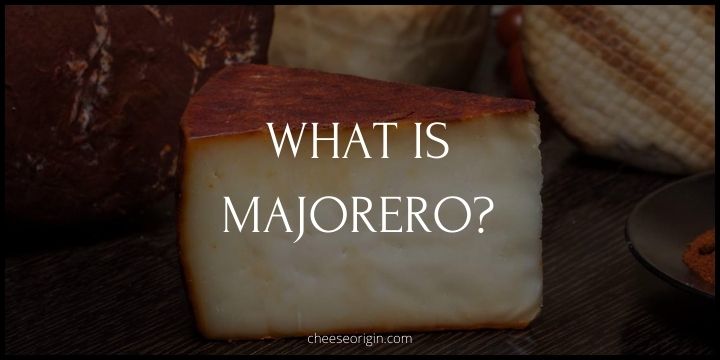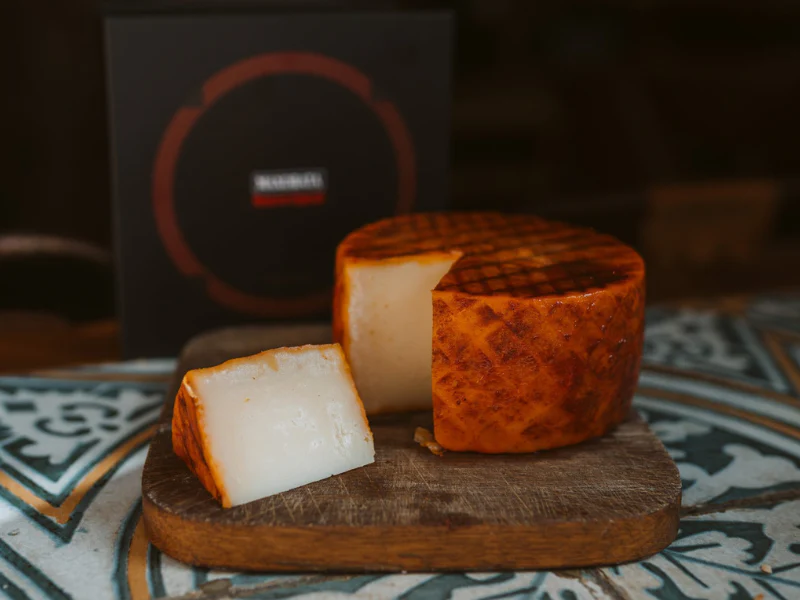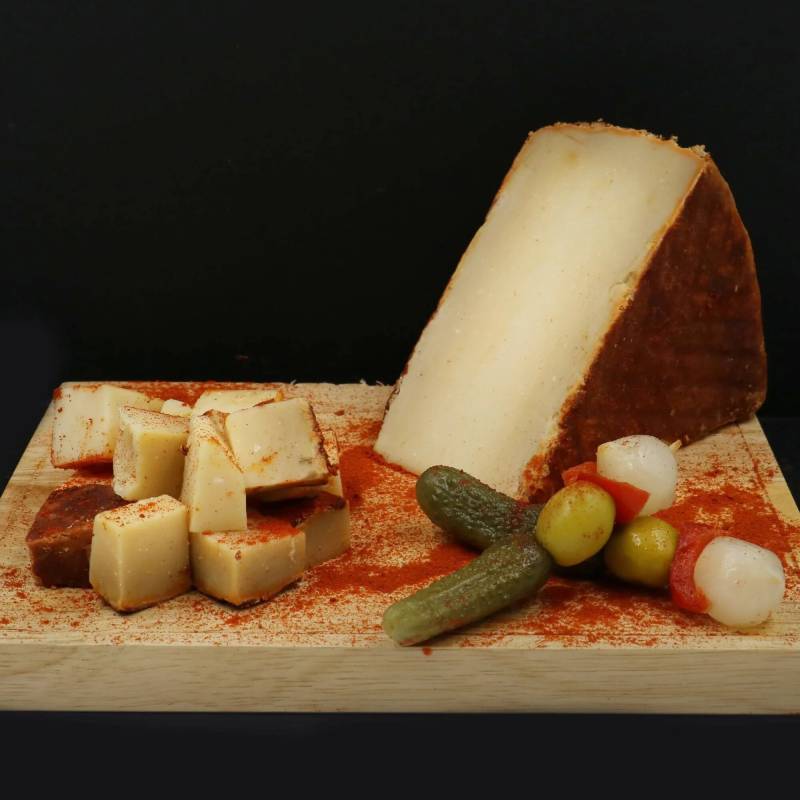What is Majorero? Spain’s Nutty Cheese Treasure

Nestled within the culinary treasures of Spain, Majorero cheese, a deliciously nutty delight, reigns supreme. Hailing from the sandy dunes and volcanic soils of Fuerteventura in the Canary Islands, this unique cheese is a testament to the island’s rich gastronomic heritage.
Created from the milk of the local Majorera goats, it boasts an unmatched flavor profile – creamy, slightly piquant, and wonderfully nutty. A true Spanish gem, Majorero is not just a cheese; it’s a taste journey that transports you to the heart of Spain’s vibrant food culture.
Quick Facts About Majorero
| Quick Facts | Details |
|---|---|
| Origin | Fuerteventura, Canary Islands, Spain |
| Made From | Goat’s milk |
| Texture | Semi-hard |
| Flavor Profile | Nutty, buttery, slightly salty |
| Aging Time | Minimum 60 days |
| PDO Status | Yes, since 1996 |
| Color | White to pale yellow |
| Rind | Natural or coated with pimento or gofio (toasted cornmeal) |
| Pairings | Fruity white wines, fig jam, crusty bread |
| Awards | Super Gold at the World Cheese Awards |
| Production Method | Artisanal and industrial |
| Shape | Cylindrical |
| Size | 1-6 kg |
| Special Feature | One of the most awarded goat cheeses in the world |
| Availability | All year round |
| Serving Suggestion | Great on a cheeseboard or melted in traditional dishes |
What is Majorero?

Majorero, a true gem of the Canary Islands, is a cheese that carries the essence of its place of origin – Fuerteventura. This Spanish island, known for its arid, volcanic landscapes, is home to the Majorera goats. These hardy creatures have adapted to the harsh conditions, producing milk that is rich, creamy, and uniquely flavored. From this milk comes Majorero, a cheese that beautifully mirrors the resilience and character of its homeland.
Majorero is a semi-hard cheese, crafted from unpasteurized goat’s milk. It boasts a distinctively nutty, buttery flavor with a slight hint of saltiness, reflecting the coastal winds that whisper through Fuerteventura’s plains. The texture is firm yet yielding, melting delightfully on the tongue. Whether it’s enjoyed fresh or aged, Majorero always offers an unforgettable gustatory experience.
One of the fascinating features of Majorero is its rind. The cheese can be found in three different variations: natural, rubbed with pimento, or rolled in ‘gofio’, a type of toasted cornmeal common in Canarian cuisine. Each variant provides a unique dimension to the cheese, enhancing its already complex profile.
Holding a Protected Designation of Origin (PDO) status since 1996, Majorero is not just a cheese; it’s a testament to tradition. The methods used to produce it have been passed down through generations, ensuring that every bite holds a piece of Fuerteventura’s history. Paired with a fruity white wine or served with crusty bread and fig jam, Majorero transforms any cheeseboard into a culinary journey.
What Does Majorero Taste Like?
When you first bite into Majorero, the initial taste is mild, creamy, and slightly sweet, reflecting the richness of the goat’s milk from which it is made. As the cheese melts in your mouth, it reveals a deeper, nutty flavor that is both satisfying and intriguing. There’s also a hint of saltiness, reminiscent of the sea breezes that sweep across the Canary Islands.
If the Majorero has been aged, the flavor becomes more intense and complex. The sweetness gives way to a stronger, more pronounced nuttiness, and there may be subtle notes of grass or hay, echoing the diet of the Majorera goats.
The rind of the Majorero also contributes to its taste. If it’s rubbed with pimento or rolled in ‘gofio’ (a type of toasted cornmeal), it adds an extra layer of flavor – a gentle smokiness or a rustic, grainy note.
Majorero Tasting Notes
- Initial Taste: Mild, creamy, and slightly sweet due to the richness of the goat’s milk.
- Secondary Flavors: As the cheese melts, a deeper nutty flavor emerges, providing a satisfying complexity.
- Saltiness: There’s a slight hint of saltiness, reminiscent of the sea breezes on the Canary Islands.
- Aged Cheese: With aging, the flavors intensify. The sweetness gives way to a stronger nuttiness, with subtle hints of grass or hay from the goats’ diet.
- Rind Influence: If the rind is rubbed with pimento or rolled in ‘gofio’, it can add a smoky or rustic, grainy note to the overall flavor.
10 Best Majorero Substitutes
| Cheese | Reason for Substitution |
|---|---|
| Manchego | This Spanish cheese has a similar texture and nutty flavor. |
| Chèvre | A goat cheese with a creamy texture that can substitute Majorero in fresh applications. |
| Gouda | Its sweet, nutty flavor makes it a good alternative. |
| Monterey Jack | This cheese melts well, making it a good substitute in cooked dishes. |
| Asiago | Asiago has a tanginess that can mimic the distinct flavor of Majorero. |
| Fontina | Its earthy and nutty flavor, along with good melting qualities, makes Fontina a good choice. |
| Cotija | This Mexican cheese has a similar salty tang and can be grated like Majorero. |
| Havarti | Havarti’s buttery flavor can make it a suitable alternative. |
| Muenster | This semi-soft cheese is good for melting, similar to Majorero. |
| Feta | While feta is crumblier than Majorero, its tangy and salty flavor can work as a substitute in some dishes. |
What Pairs Well With Majorero?

Food that goes well with Majorero:
| Category | Food Pairing |
|---|---|
| Fruits | Pears, Apples, Figs, Grapes |
| Nuts | Almonds, Walnuts, Pecans |
| Bread/Crackers | Baguette, Sourdough, Whole Grain Crackers, Rye Bread |
| Meats | Chorizo, Prosciutto, Salami |
| Jams/Preserves | Fig Jam, Quince Paste, Apricot Preserve |
| Vegetables | Roasted Bell Peppers, Marinated Artichokes, Olives |
| Desserts | Dark Chocolate, Honey, Caramelized Nuts |
| Condiments | Olive Oil, Balsamic Reduction, Truffle Honey |
| Spreads/Dips | Hummus, Tapenade, Pesto |
Also read: 11 Best Crackers that Pair Well with Cheese
Beverage that goes well with Majorero:
| Category | Beverage Pairing |
|---|---|
| White Wine | Sauvignon Blanc, Chardonnay, Riesling |
| Red Wine | Tempranillo, Pinot Noir, Merlot |
| Rosé Wine | Provence Rosé, Spanish Rosé |
| Beer | Belgian Ale, Pale Lager, Wheat Beer |
| Cider | Dry Apple Cider, Pear Cider |
| Non-Alcoholic | Sparkling Water, Fresh Pear Juice, Herbal Tea |
Also read: Best Wine and Cheese Pairings: The Ultimate Guide
Also read:
- What is Tetilla Cheese? Galicia’s Signature Cheese
- What is Pata Cabra Cheese? A Taste of Spain’s Goat Milk Mastery
- What is Bath Blue? England’s Creamy Blue Cheese Champion
- What is Milleens Cheese? The Irish Artisanal Delight
- What is Old Amsterdam Cheese? The Golden Dutch Delight
- What is Gubbeen Cheese? Ireland’s Unique Culinary Delight
- What is Piave Cheese? The Taste of Italy’s Northern Valleys





